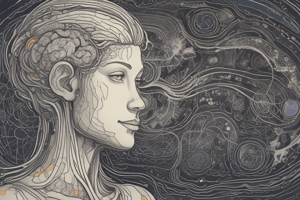Podcast
Questions and Answers
What is the characteristic feature of NREM-2 sleep?
What is the characteristic feature of NREM-2 sleep?
- Slow bodily functions characteristic
- Deep sleep with restorative functions
- Moderate sleep with sleep spindles (correct)
- Dreaming stage with high brain activity
What is the role of the medulla in the brainstem?
What is the role of the medulla in the brainstem?
- Processing visual information
- Controlling heart rate and breathing (correct)
- Bridging brain and body communication
- Regulating alertness
Which type of psychoactive drug is known to distort perceptions?
Which type of psychoactive drug is known to distort perceptions?
- Depressants
- Stimulants
- Anxiolytics
- Hallucinogens (correct)
Which process is primarily associated with the cerebral cortex's association areas?
Which process is primarily associated with the cerebral cortex's association areas?
What describes the absolute threshold in sensation and perception?
What describes the absolute threshold in sensation and perception?
What does heritability refer to in the context of behavior?
What does heritability refer to in the context of behavior?
Which neurotransmitter is primarily involved in regulating mood and is linked to depression?
Which neurotransmitter is primarily involved in regulating mood and is linked to depression?
What is a primary function of the autonomic nervous system?
What is a primary function of the autonomic nervous system?
What aspect of behavior does evolutionary psychology try to explain?
What aspect of behavior does evolutionary psychology try to explain?
Which gland is referred to as the 'master gland' of the endocrine system?
Which gland is referred to as the 'master gland' of the endocrine system?
In the context of sleep patterns, which stage is characterized as light sleep where hallucinations can occur?
In the context of sleep patterns, which stage is characterized as light sleep where hallucinations can occur?
Which type of neuron is responsible for transmitting commands from the brain to muscle tissues?
Which type of neuron is responsible for transmitting commands from the brain to muscle tissues?
What does the concept of 'gene-environment interaction' imply?
What does the concept of 'gene-environment interaction' imply?
Flashcards
Phrenology
Phrenology
A now-debunked theory that claimed personality traits could be determined by skull shape. It attempted to connect brain regions with specific functions, but lacked scientific basis.
Gene-environment Interaction
Gene-environment Interaction
The interplay between an individual's genetic makeup and their environment, influencing the expression of traits. Genes provide the blueprint, but environment plays a crucial role in shaping how those genes are expressed.
Evolutionary Psychology
Evolutionary Psychology
A field that explains how human behavior has evolved over time through natural selection. It suggests that certain traits and behaviors are more likely to be passed down if they provide an advantage for survival and reproduction.
Somatic Nervous System
Somatic Nervous System
Signup and view all the flashcards
Acetylcholine
Acetylcholine
Signup and view all the flashcards
Hypothalamus
Hypothalamus
Signup and view all the flashcards
NREM-1 Sleep
NREM-1 Sleep
Signup and view all the flashcards
Pineal Gland
Pineal Gland
Signup and view all the flashcards
Depressants
Depressants
Signup and view all the flashcards
Stimulants
Stimulants
Signup and view all the flashcards
Study Notes
Biological Bases of Behavior
-
Brain Structure & Function: Phrenology, an outdated concept, explored the correlation between skull shape and personality. This early attempt sparked interest in brain mapping. Critical thinking is crucial in psychology.
-
Genetics and Behavior: Chromosomes (23 pairs) carry genes (DNA segments) contributing to our traits. The genome is the complete genetic blueprint. Heritability describes the extent of trait variation due to genes. Gene-environment interactions are significant (environment influences gene expression).
-
Evolutionary Psychology: Natural selection explains traits like fear of heights and taste preferences. Gender differences in mate preferences are explained by evolutionary theory: men prioritize indicators of fertility; women prioritize resources. This approach faces criticism about balancing biological and social learning explanations.
Nervous and Endocrine Systems
-
Nervous System: The central nervous system (CNS) consists of the brain and spinal cord. The peripheral nervous system (PNS) contains nerves outside the CNS, including somatic (voluntary movement) and autonomic (involuntary processes) divisions, further categorized into sympathetic (fight-or-flight) and parasympathetic (rest-and-digest) systems.
-
Neurons and Neurotransmitters: Neurons are the basic units transmitting signals. Types include sensory (send info to brain), motor (transmit commands from brain), and interneurons (process signals). Key neurotransmitters include acetylcholine (muscle movement, memory), dopamine (reward, learning, emotion), serotonin (mood, hunger, sleep), and endorphins (natural pain killers).
-
Endocrine System: Hormones influence bodily functions more slowly and for longer durations than neurotransmitters. The hypothalamus regulates homeostasis, the pituitary is the "master gland" controlling other glands, the adrenal produces adrenaline for stress response, and the pineal gland secretes melatonin (sleep).
Sleep, Drugs, and Sensation
-
Sleep: Sleep cycles repeat approximately every 90 minutes. Sleep stages include NREM-1 (light sleep), NREM-2 (moderate sleep), NREM-3 (deep sleep), and REM (dreaming). Sleep is vital for memory consolidation, problem-solving, growth, and overall health.
-
Psychoactive Drugs: Categories include depressants (alcohol), stimulants (nicotine, cocaine), and hallucinogens (LSD, marijuana). Tolerance, withdrawal, and addiction are key concepts.
-
Sensation and Perception: Thresholds determine detection levels (absolute threshold for smallest detectable signal; difference threshold for minimum change detectable). Visual perception involves rods for low light and cones for color. Auditory perception relies on hair cells in the ear. Chemical sensations include taste (five basic types) and smell (linked to memory). Touch involves pressure, temperature, and pain receptors. Balance relies on the vestibular system in the inner ear.
Brain Functionality
-
Brainstem Components: The medulla controls heartbeat and breathing; the pons links brain and body communication; the reticular formation regulates alertness.
-
Cerebral Cortex: The cerebral cortex is divided into four lobes (frontal, parietal, occipital, temporal). Association areas manage complex tasks. Brain plasticity demonstrates the ability to adapt and rewire. Split-brain studies are crucial in revealing hemisphere specialization.
Studying That Suits You
Use AI to generate personalized quizzes and flashcards to suit your learning preferences.




